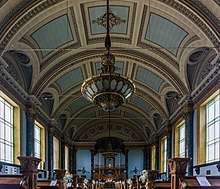Saltaire United Reformed Church
Saltaire United Reformed Church (originally Saltaire Congregational Church) is a church at Saltaire, West Yorkshire, England. Commissioned and paid for by Titus Salt in the mid 19th century, the church is a Grade I listed building and sits within the Saltaire World Heritage Site.
| Saltaire United Reformed Church | |
|---|---|
 The western frontage of the church | |
| Location | Saltaire, West Yorkshire |
| Coordinates | 53°50′20″N 1°47′27″W |
| OS grid reference | SE 138 381 |
| Built | 1858–1859 |
| Architect | Lockwood and Mawson |
| Architectural style(s) | Italianate Classical |
Listed Building – Grade I | |
| Designated | 22 November 1966 |
| Reference no. | 1314229 |
 Location within West Yorkshire | |
History
When Titus Salt, a devoted member of the Congregational church,[1] commenced the design and construction of his model village at Saltaire, a Congregational church was the first public building commissioned.[2] Salt donated the land and paid for the cost of the church himself, a cost of £16,000 (equivalent to £1,622,091 in 2019).[3]
The church was designed, as was the rest of Saltaire, by the Bradford-based architect partnership of Lockwood and Mawson in the Italianate Classical style.[4]
Since 1972 the church has been known as Saltaire United Reformed Church following the merger of Congregational Church in England and Wales and the Presbyterian Church of England.[5]
The ceiling of the church was badly damaged and partially collapsed due to being affected by Storm Dennis in February 2020.[6]
Description

The foundation stone of the church was laid by Caroline Salt (wife of Titus) in 1856 and opened in 1859. Built from local stone with an ashlar finish. The nave has no aisle and on the western end has a semi-circular portico. The portico is topped by a round tower with a clock at each quarter and above that an octagonal array of columns with a dome.[4] The main part of the church is roofed with Welsh slate and has large plain windows.[4] The organ was an 1890 addition and was built by Huddersfield firm Conacher and Co and subsequently rebuilt twice.[7] A pair of large chandeliers, originally gas lit, hang on the centre line of the nave ceiling. On the south side of the nave is the Salt family mausoleum where Sir Titus Salt was buried after his death in 1876.[1]
References
- James, David. "Salt, Sir Titus, first baronet (1803–1876)". Oxford Dictionary of National Biography (online ed.). Oxford University Press. Retrieved 24 July 2015. (Subscription or UK public library membership required.)
- Husselbee, Lesley & Ballard, Paul (2012). Free Churches and Society: The Nonconformist Contribution to Social Welfare 1800-2010. Bloomsbury Press. p. 91. ISBN 978-14411-7905-0.
- Baines, Edward (1970) [1875]. Ponting, K.G. (ed.). Baines's account of the woollen manufacture of England. David & Charles. p. 131. ISBN 978-07153-4754-6.
- Historic England. "Congregational Church (1314229)". National Heritage List for England. Retrieved 24 July 2015.
- "United Reformed/ Congregational/ Presbyterian Churches". University of Sheffield. Retrieved 24 July 2015.
- "Ceiling collapses in Saltaire's historic church". Bradford Telegraph and Argus. 25 February 2020. Retrieved 25 February 2020.
- "Saltaire, World Heritage site in West Yorkshire". Yorkshire Life. 14 February 2010. Retrieved 24 July 2015.